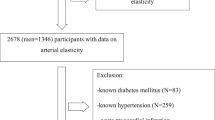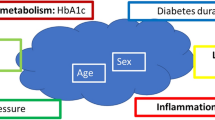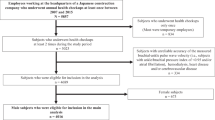Abstract
The metabolic syndrome (MetS) increases cardiovascular disease (CVD) risk. How MetS increases CVD risk is incompletely understood, but increasing arterial stiffness is one candidate link, which in turn could be explained by (low-grade) inflammation, endothelial dysfunction (ED) or insulin resistance (IR). However, MetS-related increases in stiffness may not be uniformly distributed over muscular and elastic arteries. Therefore, the purpose of this study was to determine: (1) the associations between the MetS, and muscular and elastic arterial stiffness, and (2) whether any such associations could be explained by inflammation, ED or IR. These questions were addressed in the Hoorn Study. MetS was defined according to the NCEP (National Cholesterol Education Program) criteria. Arterial stiffness was determined by ultrasound, tonometry and echocardiography. Inflammation, ED and IR were estimated by C-reactive protein, flow-mediated vasodilation and the homoeostatic model for the assessment of IR, respectively. The results showed that MetS was associated with both femoral and brachial arterial stiffness, significantly so for the distensibility coefficients and for the femoral compliance coefficient. In the carotid artery and aorta, no particular pattern emerged. Additional adjustment for either inflammation, ED or IR did not materially alter the results. The results therefore indicate that muscular arteries may stiffen preferentially over elastic arteries and that distensibility is affected to a greater extent than compliance, thus maintaining volume compliance over vessel wall stiffening. Additionally, the increase in stiffness was not explained by inflammation, ED or IR and suggests that stiffening of the muscular arteries in MetS may not be the consequence of these phenomena.
This is a preview of subscription content, access via your institution
Access options
Subscribe to this journal
Receive 12 digital issues and online access to articles
$119.00 per year
only $9.92 per issue
Buy this article
- Purchase on Springer Link
- Instant access to full article PDF
Prices may be subject to local taxes which are calculated during checkout



Similar content being viewed by others
References
Ford ES . Prevalence of the metabolic syndrome defined by the International Diabetes Federation among adults in the US. Diabetes Care 2005; 28: 2745–2749.
Hu G, Qiao Q, Tuomilehto J, Balkau B, Borch-Johnsen K, Pyorala K . Prevalence of the metabolic syndrome and its relation to all-cause and cardiovascular mortality in nondiabetic European men and women. Arch Intern Med 2004; 164: 1066–1076.
Stehouwer C, Henry R, Ferreira I . Arterial stiffness in diabetes and the metabolic syndrome: a pathway to cardiovascular disease. Diabetologia 2008; 51: 527–539.
Safar ME, Lacolley P . Disturbance of macro- and microcirculation: relations with pulse pressure and cardiac organ damage. Am J Physiol 2007; 293: H1–H7.
Ahluwalia N, Drouet L, Ruidavets JB, Perret B, Amar J, Boccalon H et al. Metabolic syndrome is associated with markers of subclinical atherosclerosis in a French population-based sample. Atherosclerosis 2006; 186: 345–353.
Czernichow S, Bertrais S, Blacher J, Oppert JM, Galan P, Ducimetiere P et al. Metabolic syndrome in relation to structure and function of large arteries: a predominant effect of blood pressure. A report from the SU.VI.MAX. Vascular Study. Am J Hypertens 2005; 18: 1154–1160.
Ferreira I, Boreham CA, Twisk JW, Gallagher AM, Murray LJ, Young IS et al. Clustering of metabolic syndrome risk factors and arterial stiffness in young adults: the Northern Ireland Young Hearts Project. J Hypertens 2007; 25: 1009–1020.
Ferreira I, Henry RM, Twisk JW, van Mechelen W, Kemper HC, Stehouwer CD . The metabolic syndrome, cardiopulmonary fitness, and subcutaneous trunk fat as independent determinants of arterial stiffness: the Amsterdam Growth and Health Longitudinal Study. Arch Internal Med 2005; 165: 875–882.
Mule G, Cottone S, Mongiovi R, Cusimano P, Mezzatesta G, Seddio G et al. Influence of the metabolic syndrome on aortic stiffness in never treated hypertensive patients. Nutr Metab Cardiovasc Dis 2006; 16: 54–59.
Nakanishi N, Suzuki K, Tatara K . Clustered features of the metabolic syndrome and the risk for increased aortic pulse wave velocity in middle-aged Japanese men. Angiology 2003; 54: 551–559.
Protogerou AD, Blacher J, Aslangul E, Le Jeunne C, Lekakis J, Mavrikakis M et al. Gender influence on metabolic syndrome's effects on arterial stiffness and pressure wave reflections in treated hypertensive subjects. Atherosclerosis 2007; 193: 151–158.
Safar ME, Thomas F, Blacher J, Nzietchueng R, Bureau JM, Pannier B et al. Metabolic syndrome and age-related progression of aortic stiffness. J Am Coll Cardiol 2006; 47: 72–75.
Schillaci G, Pirro M, Vaudo G, Mannarino MR, Savarese G, Pucci G et al. Metabolic syndrome is associated with aortic stiffness in untreated essential hypertension. Hypertension 2005; 45: 1078–1082.
Scuteri A, Najjar SS, Muller DC, Andres R, Hougaku H, Metter EJ et al. Metabolic syndrome amplifies the age-associated increases in vascular thickness and stiffness. J Am Coll Cardiol 2004; 43: 1388–1395.
van Popele NM, Westendorp IC, Bots ML, Reneman RS, Hoeks AP, Hofman A et al. Variables of the insulin resistance syndrome are associated with reduced arterial distensibility in healthy non-diabetic middle-aged women. Diabetologia 2000; 43: 665–672.
Whincup PH, Gilg JA, Donald AE, Katterhorn M, Oliver C, Cook DG et al. Arterial distensibility in adolescents: the influence of adiposity, the metabolic syndrome, and classic risk factors. Circulation 2005; 112: 1789–1797.
Alberti KG, Zimmet P, Shaw J . Metabolic syndrome--a new world-wide definition. A consensus statement from the International Diabetes Federation. Diabet Med 2006; 23: 469–480.
Kullo IJ, Seward JB, Bailey KR, Bielak LF, Grossardt BR, Sheedy II PF et al. C-reactive protein is related to arterial wave reflection and stiffness in asymptomatic subjects from the community. Am J Hypertens 2005; 18: 1123–1129.
Mahmud A, Feely J . Arterial stiffness is related to systemic inflammation in essential hypertension. Hypertension 2005; 46: 1118–1122.
Vlachopoulos C, Aznaouridis K, Stefanadis C . Clinical appraisal of arterial stiffness: the Argonauts in front of the Golden Fleece. Heart 2006; 92: 1544–1550.
Kim JA, Montagnani M, Koh KK, Quon MJ . Reciprocal relationships between insulin resistance and endothelial dysfunction: molecular and pathophysiological mechanisms. Circulation 2006; 113: 1888–1904.
Saijo Y, Yoshioka E, Fukui T, Kawaharada M, Kishi R . Metabolic syndrome, C-reactive protein and increased arterial stiffness in Japanese subjects. Hypertens Res 2006; 29: 589–596.
Tomiyama H, Koji Y, Yambe M, Motobe K, Shiina K, Gulnisa Z et al. Elevated C-reactive protein augments increased arterial stiffness in subjects with the metabolic syndrome. Hypertension 2005; 45: 997–1003.
Hunt KJ, Resendez RG, Williams K, Haffner SM, Stern MP . National Cholesterol Education Program versus World Health Organization metabolic syndrome in relation to all-cause and cardiovascular mortality in the San Antonio Heart Study. Circulation 2004; 110: 1251–1257.
McNeill AM, Rosamond WD, Girman CJ, Golden SH, Schmidt MI, East HE et al. The metabolic syndrome and 11-year risk of incident cardiovascular disease in the atherosclerosis risk in communities study. Diabetes Care 2005; 28: 385–390.
Saely CH, Aczel S, Marte T, Langer P, Hoefle G, Drexel H . The metabolic syndrome, insulin resistance, and cardiovascular risk in diabetic and nondiabetic patients. J Clin Endocrinol Metab 2005; 90: 5698–5703.
Choi KM, Lee KW, Seo JA, Oh JH, Kim SG, Kim NH et al. Relationship between brachial-ankle pulse wave velocity and cardiovascular risk factors of the metabolic syndrome. Diabetes Res Clin Pract 2004; 66: 57–61.
Henry RM, Kostense PJ, Spijkerman AM, Dekker JM, Nijpels G, Heine RJ et al. Arterial stiffness increases with deteriorating glucose tolerance status: the Hoorn Study. Circulation 2003; 107: 2089–2095.
Mooy JM, Grootenhuis PA, de Vries H, Valkenburg HA, Bouter LM, Kostense PJ et al. Prevalence and determinants of glucose intolerance in a Dutch Caucasian population. The Hoorn Study. Diabetes Care 1995; 18: 1270–1273.
Spijkerman AM, Adriaanse MC, Dekker JM, Nijpels G, Stehouwer CD, Bouter LM et al. Diabetic patients detected by population-based stepwise screening already have a diabetic cardiovascular risk profile. Diabetes Care 2002; 25: 1784–1789.
Grundy SM, Cleeman JL, Daniels SR, Donato KA, Eckel RH, Franklin BA et al. Diagnosis and management of the metabolic syndrome. An American Heart Association/National Heart, Lung and Blood Institute scientific statement. Circulation 2005; 112: 2735–2752.
Henry RM, Kamp O, Kostense PJ, Spijkerman AM, Dekker JM, van Eijck R et al. Left ventricular mass increases with deteriorating glucose tolerance, especially in women: independence of increased arterial stiffness or decreased flow-mediated dilation: the Hoorn study. Diabetes Care 2004; 27: 522–529.
Schram MT, Henry RM, van Dijk RA, Kostense PJ, Dekker JM, Nijpels G et al. Increased central artery stiffness in impaired glucose metabolism and type 2 diabetes: the Hoorn Study. Hypertension 2004; 43: 176–181.
Kelly R, Fitchett D . Noninvasive determination of aortic input impedance and external left ventricular power output: a validation and repeatability study of a new technique. J Am Coll Cardiol 1992; 20: 952–963.
Van Bortel LM, Balkestein EJ, van der Heijden-Spek JJ, Vanmolkot FH, Staessen JA, Kragten JA et al. Non-invasive assessment of local arterial pulse pressure: comparison of applanation tonometry and echo-tracking. J Hypertens 2001; 19: 1037–1044.
Stergiopulos N, Meister JJ, Westerhof N . Evaluation of methods for estimation of total arterial compliance. Am J Physiol 1995; 268: H1540–H1548.
Chemla D, Hebert JL, Coirault C, Zamani K, Suard I, Colin P et al. Total arterial compliance estimated by stroke volume-to-aortic pulse pressure ratio in humans. Am J Physiol 1998; 274: H500–H505.
O'Rourke MF, Gallagher DE . Pulse wave analysis. J Hypertens Suppl 1996; 14: S147–S157.
Nichols WW, O'Rourke MF . McDonald's Blood Flow in Arteries: Theoretical, Experimental and Clinical Principles, 5th edn. Hodder Arnold: London, 2005.
Mather KJ, Hunt AE, Steinberg HO, Paradisi G, Hook G, Katz A et al. Repeatability characteristics of simple indices of insulin resistance: implications for research applications. J Clin Endocrinol Metab 2001; 86: 5457–5464.
Henry RM, Ferreira I, Kostense PJ, Dekker JM, Nijpels G, Heine RJ et al. Type 2 diabetes is associated with impaired endothelium-dependent, flow-mediated dilation, but impaired glucose metabolism is not; The Hoorn Study. Atherosclerosis 2004; 174: 49–56.
Safar ME, Levy BI, Struijker-Boudier H . Current perspectives on arterial stiffness and pulse pressure in hypertension and cardiovascular diseases. Circulation 2003; 107: 2864–2869.
Safar ME, London GM, Asmar R, Frohlich ED . Recent advances on large arteries in hypertension. Hypertension 1998; 32: 156–161.
Kizu A, Koyama H, Tanaka S, Maeno T, Komatsu M, Fukumoto S et al. Arterial wall stiffness is associated with peripheral circulation in patients with type 2 diabetes. Atherosclerosis 2003; 170: 87–91.
Taniwaki H, Shoji T, Emoto M, Kawagishi T, Ishimura E, Inaba M et al. Femoral artery wall thickness and stiffness in evaluation of peripheral vascular disease in type 2 diabetes mellitus. Atherosclerosis 2001; 158: 207–214.
Diamant M, Lamb HJ, van de Ree MA, Endert EL, Groeneveld Y, Bots ML et al. The association between abdominal visceral fat and carotid stiffness is mediated by circulating inflammatory markers in uncomplicated type 2 diabetes. J Clin Endocrinol Metab 2005; 90: 1495–1501.
Yki-Yarvinen H, Westerbacka J . Insulin resistance, arterial stiffness and wave reflection. Adv Cardiol 2007; 44: 252–260.
Kass DA, Shapiro EP, Kawaguchi M, Capriotti AR, Scuteri A, deGroof RC et al. Improved arterial compliance by a novel advanced glycation end-product crosslink breaker. Circulation 2001; 104: 1464–1470.
Witte DR, van der Graaf Y, Grobbee E, Bots ML . Measurement of flow-mediated dilation is affected by local elastic vessel wall properties in high risk patients. Atherosclerosis 2005; 218: 323–330.
Schram MT, Stehouwer CD . Endothelial dysfunction, cellular adhesion molecules and the metabolic syndrome. Horm Metab Res 2005; 37 (Suppl 1): 49–55.
Mule G, Nardi E, Cottone S, Cusimano P, Incalcaterra F, Giandalia ME et al. Impact of metabolic syndrome on left ventricular mass in overweight and obese hypertensive subjects. Int J Cardiol 2007; 121: 267–275.
Schillaci G, Pirro M, Pucci G, Mannarino MR, Gemelli F, Siepi D et al. Different impact of the metabolic syndrome on left ventricular structure and function in hypertensive men and women. Hypertension 2006; 47: 881–886.
Acknowledgements
Dr I Ferreira is supported by a research grant (#2006T050) from the Netherlands Heart Foundation.
Author information
Authors and Affiliations
Corresponding author
Rights and permissions
About this article
Cite this article
Henry, R., Ferreira, I., Dekker, J. et al. The metabolic syndrome in elderly individuals is associated with greater muscular, but not elastic arterial stiffness, independent of low-grade inflammation, endothelial dysfunction or insulin resistance—The Hoorn Study. J Hum Hypertens 23, 718–727 (2009). https://doi.org/10.1038/jhh.2009.8
Received:
Revised:
Accepted:
Published:
Issue Date:
DOI: https://doi.org/10.1038/jhh.2009.8
Keywords
This article is cited by
-
Effects of chronic carotid baroreceptor activation on arterial stiffness in severe heart failure
Clinical Research in Cardiology (2016)
-
Carotid pulse wave velocity by magnetic resonance imaging is increased in middle-aged subjects with the metabolic syndrome
The International Journal of Cardiovascular Imaging (2015)
-
Insulin resistance and arterial stiffness in healthy adolescents and young adults
Diabetologia (2012)
-
Metabolic Syndrome in Nondiabetic Individuals Associated With Maladaptive Carotid Remodeling: The Hoorn Study
American Journal of Hypertension (2011)
-
Editors choice: recent highlights from the journal of human hypertension
Journal of Human Hypertension (2010)



